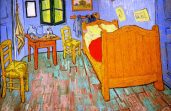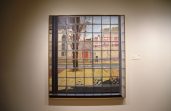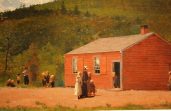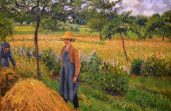March 2008
Hallowed Ground
Here beside a great oak tree I counted the corpses of fifteen men… The blue and the gray were mingled together… It was no uncommon thing to see the bodies of Federal and Confederate lying side by side as though they had bled to death while trying to aid each other” ~John A. Cockerill Sixteen-year-old Union Regimental Musician~On our first road trip through the South, I remember feeling like a guest at the White House, no matter how often you are told that it belongs to we the people, one still is acutely aware of being a guest. You can only go where directed, and must not touch anything, without permission.
We had driven from California to Tennessee, to visit Kate’s sister, Laurie and her family. After having spent several weeks on the road, we had begun to head home knowing that we had at least one stop ahead of us, a visit to the Hermitage, Andrew Jackson’s home. Touring his home and walking through the gardens, had been the perfect end to our trip.
We left his house, and found one of the many Cracker Barrel’s which line southern highways, where we enjoyed several glasses of the glorious Sothern invention of sweet tea and a meal of comfort food. As we were waiting for our check, and one last glass of tea, I began flipping through my ever present AAA book. It is my job to navigate our trips, making sure that we our on course but also offering the occasional detour, usually to some historical site. Looking through my book, I shyly asked Kate how she would feel about one more tiny stop? Where are we going now? She answered, surrendering to my insatiable appetite for large brown signs, which mark National Parks and Historical sites.
Our detour lead us west on highway 64, until the 22 and the 142 meet. It was a warm, sunny day, and the road ahead seemed endless. Large round bails of hay dotted the hilly landscape, which was decorated with picture-perfect homes and pastures filled with animals. After more than one glance of concern, we finally came upon the brown sign: “Welcome to Shiloh National Park.” I looked at Kate and smiled: “See we made it.” My smile was returned, and we drove up to the ranger station, to pay our two dollars.
The ranger station housed a museum, exhibits and a clean restroom. We were given a brochure with a map, our receipt, and wished a good afternoon. Getting back in the car, we began our driving tour of the battlefield, as directed. I read aloud, as Kate drove, stopping where called for, to read the signs and exhibits, in the field. Among the trees and hills, are granite and marble memorials to the dead. The site of each skirmish is clearly marked, and it was not difficult to recreate the battles. There was a stillness, a sorrow, a sadness in that place which could not be explained; as the dead emerged around us.
Site number five was marked: Mass Confederate Grave. What did that mean? The long rectangular, memorial was dotted with cannon balls, and is the site where 700 unknown men are buried. We read the signs, and grew quiet. In all, there five such sites at Shiloh, though there are other unknown mass graves, which remain unmarked. There are also mass graves devoted solely to the body parts which were either amputated, or simply found on the field, as well as mass graves for the horses killed in battle.
We spoke little as we made our way around the park, ending our tour at the ranger station, where it had begun. As we pulled into a parking space, I noticed that there was a cemetery across the field. We got out of the car, and headed toward the National Cemetery that was guarded by white masonry walls and a large iron gate, at the entrance. It looked like other National Cemeteries which I had seen, with relatively neat rows, of small white, marble headstones that were occasionally broken up by a larger more elaborate marker. Here, the Union had buried her boys, but I had to wonder who did the boys in the mass graves belong to?
As we made our way back to the ranger station, I no longer felt like I had been trespassing in a foreign land; instead, I felt like I had been walking on hallowed ground. It was land which had been nourished with the blood of fallen heroes, and land which held a piece of my birthright. It did not matter, if I seemed like some out-of-place Yankee, who was too ignorant to understand the obvious, I had to ask: Why are the Confederate soldiers buried in mass graves, and the Union soldiers buried in the cemetery?
Thus begun my history lesson: The battle at Shiloh, which lasted two days, began on Sunday April 6, 1862, with staggering losses to both sides. The Union suffered the loss of 1,754 men, with another 8,408 being wounded and 2,885 missing in action. The Confederates lost 1,728, had 8,012 wounded, and 959 were reported missing. General William Tecumseh Sherman said the battle site was covered with “piles of dead soldiers’ mangled bodies… without heads and legs … the scenes of this field would have cured anybody of war.
By Tuesday morning, after days of rain and heat, the battle decided, the question of what to do with the dead was raised. In this case, to the victor not only went the spoils, but the job of burying the dead. How, in the midst of war, do you bury nearly 4,000 men?
Because of the threat of disease, General Ulysses S. Grant ordered everyone to be buried as quickly as possible. There was no time for honors to be rendered, the war continued, and the dead were buried without a funeral cortege, or caisson, or Old guard. There were no flag draped coffins, twenty-one gun salutes or the playing of taps.
After the war, the Union soldiers at Shiloh were reinterred, in the Federal Cemetery. The Confederate were left in their mass graves.
Since the end of the Civil War, we have all but a made a religion out of the burial of our war dead – especially the unknown soldier. Yet as Shiloh, there are mass graves with no eternal flame, to warm them, or guard to keep watch. These mass graves are the tombs of men who died trying to resolve questions which James Madison, Gouverneur Morris and Roger Sherman were unable to answer. Either by birth or by choice, they were Americans who clung to the notion that the only way we could have a powerful nation, was if power was shared between the States and the Federal government. The governed had to consent to be governed.
The prodigal son who dies in the midst of a quarrel with his father, is no less his son. After the war, peace was accepted and the prodigal sons welcomed back into the Union. Yet, when his brothers were reburied, with honors being rendered, the Confederate soldiers were left in their mass graves. I asked the ranger why? He did not have an answer, but he did say that the Daughters of the Confederacy call those mass graves – graves of honor. It would be impossible for me to argue with them.
As we left the park that day, the sun was beginning to set and it appeared that rain was on the horizon. There was nothing left to be said. . . that is all for now.
~ M ~
March 2008
I Choose Life
“It is perhaps worth reminding those sentimental purists who believe that, in order to sit down in front of the typewriter, you have to experience grandiose feelings such as creative ‘need’ or ‘impulse,’ which are always ‘spontaneous’ or terribly intense, that the majority of the sublime words of art produced over the centuries – especially in painting and music – were the result of commissions or of even more prosaic or servile stimuli.” ~ Javier Marias ~This morning, as I sat on the porch, drinking my café con leche, I read When I was Mortal, a collection of short stories, by Marias. Half way through the small volume, I went back to read the introduction. He spoke about how the collection, with rare exception, was commissioned works, written within the confines of their original publishers mandates.
As I continued reading the stories, I thought about how unromantic and yet honest his statement had been. For those of us, burdened by a romantic nature, we often seek the perfect setting, believing that we require ambiance in order to create, but that is not so – we simply have to choose to do. Marias was correct, creating is a process begun by taking up the tools of the trade; as is life.
Life is not lit by shimmering sunlight, scented by gardenias, with a Los Panchos soundtrack. Instead, it is a string of moments which define who we are going to be – whether or not we are aware of the moment, does not lessen its impact or importance. Too often, we are under the false impression that in life we have but one defining moment, we do not.
I was reminded today of such a moment. It came in the form of a stinging accusation. “You left me!” My first reaction was furry and frustration. What I so clearly see, how can it be that someone else would so confuse? But in that moment, when you take a deep breath, before answering the absurd, I said yes; instead of trying to logically lay out the series of events, which transpired, to inspire my exit, I simply, and triumphantly, said yes. Yes, I left. Exhale. It was a terrible moment, a moment which lasted for years; but the moment is over – it has passed.
It was a defining moment – then and now – choosing to leave then, and owning my choices now. Choosing to leave an unhealthy, suffocating, oppressive life was the moment – choosing to live, to flourish, to go forward, despite the loss, was the moment. I will not apologize for choosing to survive instead of succumbing.
It is easy to feel sorry for people who are abusive. They are often very good at manipulating others, and once under their spell, their worries, needs, and shortcomings become everyone else’s problem. One somehow feels that if you only try harder, run faster, suffer longer, you can save them; but the only person who can save you is you. We either choose to live or we choose to die. I chose life. I still choose life.
There is only one constant in an abusive relationship, and that is the apology. There is always an apology – accepting or rejecting the apology is irrelevant. Whether the relationship is physically or emotionally abusive is unimportant, what matters is whether or not the victim chooses to be a survivor.
There is great guilt in being in an abusive relationship, especially if you are intelligent enough to realize that you are being abused. I think things have changed, a bit. There seem to be more resources today, than there were twenty-five years ago, and certainly domestic violence is no longer a strictly taboo subject. But abuse continues, and the victims continue to live in silent prisons.
I was lucky, I got out. I think one of the hardest journeys of my life, was leaving an unhealthy relationship, especially as it was with a person that I loved. Looking back, I am forced to confront my own short comings and failures – the long list of bad choices that allowed me to become a victim. However, I will not own the other person’s behavior.
I knew then, that I was not equipped to live with an addict and that I would never understand their world. I know now, that it was a world that I did not want to understand, and I will not apologize for that either.
Any moment now, Kate will arrive from Miami, where she has been on business. She has stopped on Calle Ocho, the heart of Little Havana, to buy Cuban pastries. We will sit on the porch, listening to the Gypsy Kings, eating our pastries, drinking our coffee, enjoying the clear, blue sky, and gentle breeze, scented with jasmine and roses – that is all for now.
~ M ~
March 2008
Feminism
“A word grows to a thought – – a thought to an idea – – an idea to an act. The change is slow, and the present is a sluggish traveler loafing in the path tomorrow wants to take.” ~ Beryl Markham ~ West with the NightI stumbled into feminism. It began as a word and grew into an act. The act has taken on many forms, the most significant being my desire to share empowerment with those that I love the most. I would hate to think where my life might be had The Woman’s Room, by Marilyn French been more than twenty-five cents. With the exception of my personal faith, there is nothing that has had a greater impact on my life than feminism.
For me, 1986, was a water shed year. It started with a Christmas gift from Caroline, my younger sister, which proved to be one of my most favorite possessions. She gave me the perfect journal – every day was dated, and there was plenty of room to write, without silly lines, which would never hold my script. Thus, the year became one of the best documented, in my life, of journaling. It was the year I left an abusive relationship, lost my first love, my father died, I moved in with Caroline, saw my Mother begin our families journey back to the East Coast, returned to Europe, went to Israel, was raped, kidnapped, met my very own Peter and John, moved to Columbus, and became a feminist.
When I came back from Europe, in 1986, I came back very ill — I had a respiratory infection, which was treated by a doctor in Jerusalem, who told me I need to rest and let my body heal. I flew back to Paris, took a train to Madrid, flew to New York City, and seriously wondered if I could start a new life there with a thousand dollars. I literally spent hours in JFK debating what to do with my life. I did not want to go back to Los Angeles, but could barely hold my head up, so I took a flight to Columbus, Ohio, where Caroline and my Mother were living.
I did not tell them I was coming. I took a cab from the airport, and remember them running out to greet me and nothing more, for the next two weeks. I was feverous and could hardly breathe, my Mother says I showered, and slept, would get up to use the restroom, drink some tea, and go back to bed. My first outing, once I began to feel better, was to a second hand store, of course, with my Mother.
I remember going to the books, and looking for something to read, as it was winter and I did not much feel like any thing else. I had never heard of French, but the title appealed to me, as did the art work, on the cover. The title page had the words: The Ladies Room, written in red. Over the word Ladies, Woman’s had been written in black. I was intrigued with the use of words, and wondered where the author might be going with Ladies and Woman’s.
I paid the twenty-five cents, and brought The Woman’s Room home, to my bed, where I began to read. Immediately, I could relate to Mira, the primary character, who was hiding in the woman’s room at Harvard, trying to gain needed courage, to deal with life. I had hidden out, at Rio Hondo Jr. College, not quite Harvard, I remembered the experience perfectly well. Being terrorized and over whelmed by life and yourself. The more I read that book, the more I found myself in every page. There was not a single character, in the book, which I did not relate to, and that shocked me. I needed more. I went down to Ohio State, and got a job at the book store, so that I could afford to buy books, at a discount. I bought and read every feminist book I could find, and they changed my life.
It had been a traumatic year, and I did not understand the things which happened and how I had reacted. I had thought of myself as a strong woman, who gained that strength from her faith and family; yet there was a conflict between my perception and reality.
I came from a home of strong women who were powerless. My mother and my sisters are both licensed and lay members of the clergy, a world that is still dominated by men, especially in fundamental faiths. Regardless of their vocation and achievements within their fields, they have continually been defined by their husbands, and limited because they were women. My mother had the same job that my father had, but she never received the respect or recognition which he did; nor did he ever have to deal with the responsibilities in our home that she was forced to address. I grew up watching my mother struggle for validation, and now see my sisters dealing with the exact same issues. Yet none of these women will call themselves feminist – – they see feminism in conflict with Christianity.
My favorite portion of scripture says, “Then after I have poured out my rains again, I will pour out my Spirit upon all people. Your sons and daughters will prophesy. Your old men will dream dreams. Your young men will see visions. In those days, I will pour out my Spirit even on servants, men and women alike.” (Joel 2: 28-29 RSV) I remember reading that for the first time when I was eleven years old, and thinking this is great! Something about me – I am definitely a daughter and plan to become a woman. This verse, which appears again in Acts, is interpreted by Protestants to deal with the time period after Christ’s death. The time period of course in which I was living. I felt then, and still do, that it was God’s provision for my equality. If God could see fit to one day give women the same spiritual gifts as men, then it seemed like the rest of the world should be able to handle this simple concept.
When I watched Yentel, the Barbra Streisand film, I remember thinking how fortunate I was to have the freedom to study my faith. I have read through the Bible a half a dozen times, and have loved the journeys that the study of those ancient texts has taken me on. I grew up in home where study was encouraged and applauded. Yet by the same token, I also grew up in a home where it was made very clear to me that as a Latin and Christian woman I should use my intelligence to amuse my husband, who of course was supposed to be a minister, and help my children with their homework. What I found so terribly confusing was that my father actually liked smart, powerful women who were in control of their life; and my mother was a smart, powerful woman who struggled daily for more control of her life.
As I grew older, the conflict between being a passive and dutiful young lady, and a curious and engaged woman became unbearable. In order to honor the values I was raised with I was supposed to be silent. I was not to raise my voice, question male authority, or fight back. The problem with being that disempowered person was that I became a victim. Becoming a feminist eventually gave me the courage to not only address having been raped, but all areas of my life in which I behaved as if I were powerless.
After I moved to Maine, my two oldest nieces, came to spend the summer. At the time, they were getting ready to enter sixth and eighth grade respectively. These were girls that were raised with very similar though not identical values, as to what I have already described. I decided to take them on a road trip. My mother is from Ohio, and though we moved a great deal growing up, our family did spend significant amounts of time in the state. I thought I would take them to see some of the places that had some meaning in our families life, as well as to see Niagara Falls, and a brief trip to Seneca Falls.
You can not imagine the resistance they both put up when I mentioned going to see the National Woman’s Hall of Fame. I think they would have both given up Christmas and birthday gifts, for the next five years, in order to avoid going to one of Auntie’s weird women things. We began our journey at the visitor’s center, for the Women’s Rights National Historical Park. They liked the life-size sculptures of the first leaders of the women’s rights movement, but simply because they could touch the bronze figures. They sat through the introductory film unimpressed, and wondered around the building with a look that said, okay we have seen it, and can we leave now? Not even the gift center enticed those two. We next went to Wesleyan Park Chapel, where I made them read the words from the Declaration of Sentiments that are inscribed, on the fountain, in the park. I explained what had happened, on the ground we were standing on, forced them to pose for me, and all but concluded that I have never seen either one more miserable. Perhaps a kinder aunt would have taken them for ice cream, at that point; but I decided to press on and comforted myself with the idea that they would later definitely enjoy the Erie Canal Museum, which they did.
First, however, we walked down the street and entered The National Women’s Hall of Fame, in theory the most non-engaging of the sites in Seneca Falls. The hall basically has framed photographs of women, accompanied by brief biographical notes. I thought we would be in and out of that building in ten minutes; but then the most amazing thing happened – my oldest niece, Beth, saw a picture of Sojourner Truth. “Look Auntie, I know her. We read about her in school. She was really this great woman.” Within seconds, Allison, her sister had found Amelia Earhart. For the next few hours, the girls pulled me back and fourth between their finds. They were reading about real women who had made a contribution to the world. Some were people that they had heard of, and others were people who stirred them to say, “I didn’t know she had done that!” So Susan B. Anthony and Lucretia Mott did not impress them, that was okay. I would settle for Elizabeth Blackwell, Clara Barton, and Sally Ride. Gladly, I paid for the postcards, pencils, and books the girls found in the Hall’s gift shop, that they simply had to have; and they were happy to go on to the Elizabeth Cady Stanton home.
It has now been many years since that summer, and I do not think the girls would be any more comfortable with identifying themselves as feminist, than their mother or mine is; but that have become strong, passionate, powerful women, who are in control of their lives. I hope I have played some small part in their view of womanhood – that is all for now.










